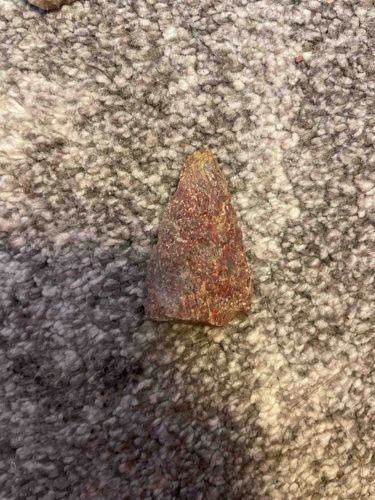
Reddish-Brown Rock Fragment
The item is a small, irregularly shaped geological specimen, likely a fragment of a larger rock or mineral formation. It exhibits a predominant reddish-brown to burnt sienna coloration, with some lighter speckles that could indicate crystalline inclusions or weathering effects. The surface appears somewhat rough and unpolished, consistent with a natural fracture or a piece that has undergone some degree of erosion. Its form is roughly triangular or wedge-shaped, tapering to a somewhat blunted point at one end. The base or wider section is not perfectly flat, suggesting a naturalbreak. There are no obvious signs of tooling marks, artificial shaping, or human modification, suggesting it is a natural geofact rather than an artifact. The overall condition appears stable, with no visible cracks, chips, or significant signs of deterioration. The material appears dense and somewhat granular, hinting at a possible composition of a durable stone such as quartz, granite, or a similar silicate mineral. Without closer inspection or testing, it’s difficult to pinpoint the exact mineralogy, but its appearance is consistent with naturally occurring rock fragments found in various geological settings. There are no discernible maker's marks, signatures, or specific manufacturing details, as it is a natural object. Its age is geological, extending back potentially millions of years, while its 'style period' is simply 'natural formation'. The quality indicators are in its natural aesthetic and integrity as a piece of earth material.
AI-Generated Appraisal Disclaimer
Estimated Value
$1 - $5
Basic Information
Category
Mineral Specimen / Geofact
Appraised On
November 28, 2025
Estimated Value
$1 - $5
Item Description
The item is a small, irregularly shaped geological specimen, likely a fragment of a larger rock or mineral formation. It exhibits a predominant reddish-brown to burnt sienna coloration, with some lighter speckles that could indicate crystalline inclusions or weathering effects. The surface appears somewhat rough and unpolished, consistent with a natural fracture or a piece that has undergone some degree of erosion. Its form is roughly triangular or wedge-shaped, tapering to a somewhat blunted point at one end. The base or wider section is not perfectly flat, suggesting a naturalbreak. There are no obvious signs of tooling marks, artificial shaping, or human modification, suggesting it is a natural geofact rather than an artifact. The overall condition appears stable, with no visible cracks, chips, or significant signs of deterioration. The material appears dense and somewhat granular, hinting at a possible composition of a durable stone such as quartz, granite, or a similar silicate mineral. Without closer inspection or testing, it’s difficult to pinpoint the exact mineralogy, but its appearance is consistent with naturally occurring rock fragments found in various geological settings. There are no discernible maker's marks, signatures, or specific manufacturing details, as it is a natural object. Its age is geological, extending back potentially millions of years, while its 'style period' is simply 'natural formation'. The quality indicators are in its natural aesthetic and integrity as a piece of earth material.
Related Tags
Get Your Items Appraised
Instant estimates of your treasures with AI-powered instant appraisals